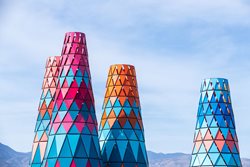
At this year’s Coachella Valley Music & Arts Festival (Indio, California), the landscape pulsed with movement, light, and transformation. Curated by Public Art Company (PAC) founder Raffi Lehrer in collaboration with Goldenvoice’s Paul Clemente, the 2025 art program foregrounded the ephemeral—works that shimmer, ripple, and vanish in the desert sun.
The installations explored the boundaries between presence and illusion, gravity and weightlessness.
 Take Flight - Photography By Lance Gerber (Courtesy Coachella).
Take Flight - Photography By Lance Gerber (Courtesy Coachella).
Take Flight by Isabel + Helen reimagines wind generated movement in a 60-foot kinetic sculpture. It embodies a spirit of inventorship and adventure, responding to the environment and winds of the Coachella Valley. It’s motorized turbines spin rhythmically, creating a mesmerising interplay of motion and light. By day, the structure offers a serene presence; a complex structure of simple yet hypnotic motion, by night, it transforms into luminous psychedelic patterns, reflecting the desert’s ever-changing energy.
 Take Flight - Photography By Lance Gerber (Courtesy Coachella).
Take Flight - Photography By Lance Gerber (Courtesy Coachella).
In Le Grand Bouquet, Uchronia imagines a landscape where flowers do not wilt, and nostalgia blooms anew. A constellation of luminous, inflatable flowers stretches toward the sky, each softly glowing against the desert backdrop. As day turns to night, Le Grand Bouquet oscillates between two states—a surreal garden bathed in sun and an illuminated mirage that hovers just at the edge of reality. Beneath its oversized petals, festivalgoers find spaces of gathering, shade, and reverie, as though caught in a fleeting, dreamlike springtime.
 Le Grand Bouquet - Photography By Lance Gerber (Courtesy Coachella).
Le Grand Bouquet - Photography By Lance Gerber (Courtesy Coachella).
 Le Grand Bouquet - Photography By Lance Gerber (Courtesy Coachella).
Le Grand Bouquet - Photography By Lance Gerber (Courtesy Coachella).
Taffy by Stephanie Lin dissolves architecture into atmosphere. Seven towering cylinders, veiled in scalloped mesh, rise and ripple with the wind, their translucent surfaces creating shifting moiré patterns that flicker in and out of visibility. Taffy exists at the intersection of materiality and impermanence—solid but transparent, rigid but soft, ephemeral yet monumental.
 Taffy - Photography By Lance Gerber (Courtesy Coachella).
Taffy - Photography By Lance Gerber (Courtesy Coachella).
Its colors, drawn from midcentury desert modernism, mutate with the changing light, fading and intensifying as the sun moves across the sky. Beneath them, curved benches offer festivalgoers a place to slow down, as though sitting inside a mirage.
 Taffy - Photography By Lance Gerber (Courtesy Coachella).
Taffy - Photography By Lance Gerber (Courtesy Coachella).
The Coachella Art Program, which evolved into its current form in 2016, is known for merging artistic expression with architectural ambition. With most works designed and fabricated on-site, the festival's installations emphasize structural integrity as much as visual impact—often drawing on the expertise of architects, designers, and large-scale fabricators.
 Photography By Lance Gerber (Courtesy Coachella).
Photography By Lance Gerber (Courtesy Coachella).
This year, sustainability played a key role. Lehrer emphasized the importance of modular, demountable design and end-of-life planning, ensuring that many artworks live beyond the festival. Past pieces have found permanent homes in public spaces, like Diébédo Francis Kéré’s Sarbalé Ke, “the House of Celebration”, now a pavilion in nearby Indio.
 Photography By Lance Gerber (Courtesy Coachella).
Photography By Lance Gerber (Courtesy Coachella).
At its core, the 2025 Coachella art program invited visitors not just to witness art—but to inhabit it. Each piece became a fleeting mirage, a spatial poem, and a shared memory in motion.
 Photography By Lance Gerber (Courtesy Coachella).
Photography By Lance Gerber (Courtesy Coachella).
 Photography By Lance Gerber (Courtesy Coachella).
Photography By Lance Gerber (Courtesy Coachella).
*
Cover image: Stephanie Lin, Taffy. Photography By Lance Gerber (Courtesy Coachella)



 29
29
comment